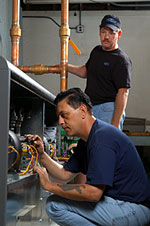
"We're always interested in ways to be more energy efficient," said Mark Wagner, director of Recreational and Community Services for the city of Los Alamitos. "And, we're looking at a minimum of $5,000 in energy savings each year [from the boiler retrofit]. Especially with the budget impacts we're all facing, these are the kinds of numbers that mean a lot."
Located on the grounds of the Joint Forces Training Base (formerly the Los Alamitos Naval Air Station), the pool was built in 1942 for training World War II pilots in ocean survival techniques. Because of the pool's size, it also became a part-time training and competition site for water polo.
The pool was the site of the U.S. National Championship tournament in 1952 and served as the training center for the 1972 U.S. Olympic team. After the Vietnam conflict, use of the base was transferred to the California National Guard. Due to military budget cuts, the pool became a victim of neglect.
Initial repairs began prior to the 1996 Olympics in Atlanta, but efforts stalled when the men's national water polo team, which used the pool for training, failed to win a medal.
Two years later, the city of Los Alamitos entered into a joint effort with USA Water Polo Inc. to open the facility for regional use, spearheading the funding that allowed new water filtration and heating systems, as well as lighting and permanent bleachers to be installed. Today, more than 300 people use the facility each day, including local swim club members, city residents, and military personnel.

New Boilers Installed
Because of the heavy use requirements of the facility, water temperature is maintained between 81 degrees and 83 degrees F, 24 hours a day. Energy consumption is a constant concern. And, because the old heating system was limping along at less than 80 percent AFUE, the city chose to replace the existing water heaters with two of the newest boiler/water heaters from Laars Heating Systems.The first of these, assigned as the primary heat source for the pool, is a Rheos Plus 2400 (2,400,000 Btuh) boiler/water heater, a high-efficiency, fully modulating condensing unit that offers up to 97 percent efficiency.
"The unit is perfectly suited for the job because its controls monitor the demand for hot water and automatically adjust to the boiler's capacity to meet the required heating load from 1.2 million to 2.4 million Btu's," said Dave Carlson, owner of DCM Mechanical, the plumbing and mechanical firm chosen to do the installations.
"The Rheos provides an infinite variability of modulation between 100 percent and 25 percent of the input rate."
"They're an environmental win, too," said Wagner. "These are among the ‘greenest' heating systems on the marketplace, with NOx levels of less than 10 ppm and low CO greenhouse gas emissions, and offer up to 96 percent efficiency - a definite win here in California."
He noted the high-efficiency boiler reduced the amount of natural gas required to heat the pool water, lowering energy consumption and operating cost.
Piped in lead-lag fashion to the Rheos, and serving as the secondary heater, is a Pennant 2000 (2,000,000 Btuh) boiler, which operates at 85 percent efficiency. The fan-assisted, sealed combustion boiler has a 2 million Btu capacity that offers four-stage control to meet demand as needed.
Its two ignition modules permit each burner stage to fire independently. This patented design offers balanced airflow to each stage, enabling operation as individual water heaters. This permits the unit to continue operation without having to shut down the entire heater.
"It's like having a built-in standby water heater," said Carlson. "If there would be failure of one of the ignition systems, the other takes over. That's unlike any other water heater, and was an important factor for us."
Both of the hydronic units from Laars meet ANSI boiler and pool heater codes, as well as Southern California requirements for low NOx emissions.
"The previous heaters really worked hard," said Mike Elmore, West and Southwest territory service manager for Laars. "But, the efficiency of the two new units, when averaged together, is 10 or more percentage points higher than the existing pool heaters. Programming for temperature control also is more accurate than ever before, within 1/10 of one degree."
Publication date: 10/11/2004




